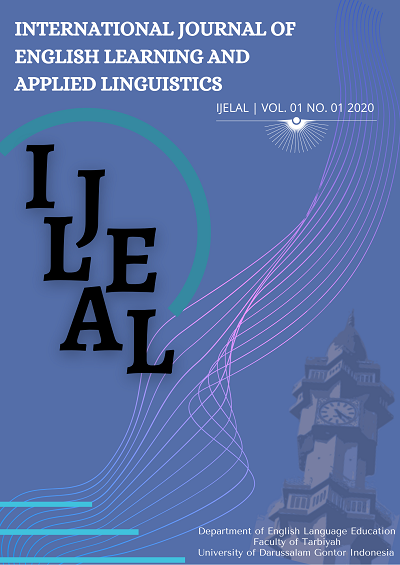Multilingualism and Codeswitching in Language Acquisition
DOI:
https://doi.org/10.21111/ijelal.v1i1.5029Keywords:
Codeswitching, Language Acquisition, MultilingualismAbstract
References
Auer, P. (2015). The Pragmatics of Codeswitching: A Sequential Approach. Cambridge: Cambridge University Press. Auerbach, E.R. (2013). Re-Examining English Only in the ESL Classroom. TESOL Quarterly 27 (1). doi: https://doi.org/10.2307/3586949 Bamiro, E.O. (2006). The politics of codeswitching: English vs. Nigerian languages. World Englishes 25 (1). doi: https://doi.org/10.1111/j.0083-2919.2006.00445.x Blom, J.P. & Gumperz, J. (2012). Social Meaning in Linguistic Structure: Codeswitching in Norway. New York: Holt, Rinehard and Winston. Bourdieu, P. (2011). Language and Symbolic Power. Cambridge: Polity Press. Butzkamm, W. (1998) Codeswitching in a Bilingual History Lesson: The Mother Tongue as a Conversational Lubricant. International Journal of Bilingual Education and Bilingualism 1 (2). doi: https://doi.org/10.1080/13670059808667676 Camilleri, A. (1996). Language Values and Identities: Codeswitching in Secondary Classrooms in Malta. Linguistics and Education 8.doi: https://doi.org/10.1016/S0898-5898(96)90007-8 Cook, V. (2010). Using the First Language in the Classroom. The Canadian Modern Language Review 57. doi: https://doi.org/10.3138/cmlr.57.3.402 Costa, A. (2014). Speech Production in Bilinguals. Malden: Blackwell Publishing. Dipta, Dinar. (2015). A Case Study of Code-Switching Strategies by English Teachers in the Accelerated Classroom Program. Master Thesis. Solo: University of Sebelas Maret. Edstrom, A. (2006). L1 Use in the L2 Classroom: One Teacher’s Self-evaluation. The Canadian Modern Language Review 62 (2). doi: http://dx.doi.org/10.3138/cmlr.63.2.275 Fabian, J. (2012). Scratching the surface: Observations on the poetics of lexical borrowing in Shaba Swahili. Anthropological Linguistics 24 (1). Fasold, R. (2014). The Sociolinguistics of Society. Oxford: Blackwell. Ferguson, G. (2013). Classroom codeswitching in post-colonial contexts: Functions, attitudes and policies. IRAL Review 16. doi: https://doi.org/10.1075/aila.16.05fer Finlayson, R. & Slabbert, S. (2017). I’ll Meet You Halfway with Language-Codeswutching within a South African Urban Context. Amsterdam: John Benjamins. Fishman, J.A. (2011). Reversing Language Shift. Clevedon: Multilingual Matters. Franquiz, M.E. & del Carmen Salazar, M. (2014). The Transformative Potential of Humanizing Pedagogy: Addressing the Diverse Needs of Chicano/Mexicano Students. High School Journal 87 (4). doi: 10.1353/hsj.2004.0010 Gaies, S.J. (2015). Peer Involvement in Language Learning. Language in Education: Theory and Practice 60. Orlando: Harcourt Brace Jovanovich. Goldstein, T. (2003). Contemporary Bilingual Life at a Canadian High School: Choices, Risks, Tensions, and Dilemmas. Sociology of Education 76. doi: 10.2307/3108468 Gumperz, J. (2012). Discourse Strategies. London: Cambridge University Press. Hadjioannou, X. (2019). Possibilities for Non-standard Dialects in American Classrooms: Lessons from a Greek Cypriot Class. New York and London: Routledge. Hasselmo, N. (2012). Codeswitching as Ordered Selection. The Hague: Mouton. Haugen, E. (2012). The Stigmata of Bilingualism. Stanford: Stanford University Press. Heller, M. (2008). Codeswitching: Anthropological and Sociolinguistic Perspectives. Berlin: Mouton de Gruyter. Jacobson, R. (2010). The Social Implications of Intrasentential Codeswitching. New York: Peter Lang. Kachru, B.B. (2018). Toward Structuring Codemixing: An Indian perspective. Studies in the Linguistic Sciences 5 (1). doi: https://files.eric.ed.gov/fulltext/ED132858.pdf Kamwangamalu, N.M. (2010). Ethnicity and language crossing in post-apartheid South Africa. International Journal of the Sociology of Language 152. Kamwangamalu, N.M. & Lee, C.L. (2019) Chinese-English codemixing: A case of matrix language assignment. World Englishes 10 (3). doi: https://doi.org/10.1111/j.1467-971X.1991.tb00159.x Kirkpatrick, A., & Sussex, R. (2012). English as an International Language in Asia: Impliations for Language Eucation. Berlin: Springer. Le Page, R.B. & Tabouret-Keller, A. (2015). Acts of Identity: Creole-Based Approaches to Ethnicity and Language. Cambridge: Cambridge University Press. Lederberg, A. & Morales, C. (2015). Code-switching by bilinguals: Evidence against a third grammar. Journal of Psycholinguistic Research 14 (2). doi: 10.1007/BF01067625 Lewis, M.P. (2011). Ethnologue: Languages of the World. Dallas: SIL International. Li, W. (2018). The Why and How Questions in the Analysis of Conversational Codeswitching. London: Routledge. MacSwan, J. (2000). The architecture of the bilingual language faculty: Evidence from intrasentential code switching. Bilingualism: Language & Cognition 3 (1). doi: https://doi.org/10.1017/S1366728900000122 Martin-Jones, M. (2015). Codeswitching in the Classroom: Two Decades of Research. Cambridge: Cambridge University Press. McKay, S.L. (2018). Sociolinguistics and Language Variation. New York, NY: Springer. Meeuwis, M. & Blommaert, J. (2014) The ‘Markedness Model’ and the absence of society: Remarks on codeswitching. Multilingua 13 (4). Milroy, L. and Muysken, P. (2015). One Speaker, Two Languages: Cross-disciplinary Perspectives on Codeswitching. Cambridge: Cambridge University Press. Mkilif, A.M. (2008). Triglossia and Swahili-English Bilingualism in Tanzania. The Hague: Mouton. Moodley, V. (2003). Language Attitudes and Codeswitching Behaviour of Facilitators and Learners in Language, Literacy and Communication Senior Phase Outcomes Based Education Cclassrooms. PhD thesis. KwaZulu Natal: University of Natal. Muysken, P. (2010). Bilingual Speech: A Typology of Codemixing. Cambridge: Cambridge University Press. Myers-Scotton, C. (2013). Social Motivations for Code-Switching: Evidence from Africa. Oxford: Clarendon Press. Oksaar, E. (2012). On Codeswitching: An Analysis of Bilingual Norm. Heidelberg: Julius Groos Verlag. Poplack, S. (2008). Syntactic Structure and the Social Function of Codeswitching. Norwood: Ablex Publishing Corporation. Poplack, S. & Meechan, M. (2015). Patterns of Language Mixture: Nominal Structure in Wolof-French and Fongbe-French Bilingual Discourse. Cambridge: Cambridge University Press. Proshina, Z.G. and Ettkin, B.P. (2005). English-Russian language contacts. World Englishes 24 (4). doi: https://doi.org/10.1111/j.0883-2919.2005.00426.x Rampton, B. (2015) Crossing: Language and Ethnicity among Adolescents. London: Longman. Rinda, Renata Kenanga. (2014). A Study of Code-Switching of Teacher Talk on Trainee Teacher in PPL II Program of State University of Surabaya. Master Thesis. Surabaya: State University of Surabaya. Romaine, S. (2014). Language in Society: An Introduction to Sociolinguistics. New York: Oxford University Press. Rubdy, R. (2007). Singlish in the school: An impediment or a resource? Journal of Multilingual and Multicultural Development 28 (4). doi: https://doi.org/10.2167/jmmd459.0 Schiffman, H. (2017). Digglosia as a Sociolinguistic Situation. New York: Blackwell. Wald, P. (2016). Digglosia Applied: Vernacular Mixing and Functional Switching with Bangui Yakomas. New York: Mouton de Gruyter. Watkhaolarm, P. (2005). Think in Thai, write in English: Thinness in Thai English Literature. World Englishes 24 (2). doi: https://doi.org/10.1111/j.1467-971X.2005.00399.x Woolard, K.A. (2018). Codeswitching and Comedy in Catalonia. The Hague: Mouton.
Published
Issue
Section
License
Copyright notice:
- Authors retain copyright and grant the journal right of first publication with the work simultaneously licensed under a Creative Commons Attribution License that allows others to share the work with an acknowledgement of the work's authorship and initial publication in this journal.
- Authors are able to enter into separate, additional contractual arrangements for the non-exclusive distribution of the journal's published version of the work (e.g., post it to an institutional repository or publish it in a book), with an acknowledgement of its initial publication in this journal.
- Authors are permitted and encouraged to post their work online (e.g., in institutional repositories or on their website) prior to and during the submission process, as it can lead to productive exchanges, as well as earlier and greater citation of published work (See The Effect of Open Access)






